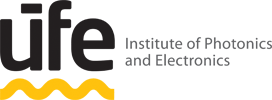| Optical biosensor for rapid detection and identification of chemical and biological substances in the field |
| Assoc. Prof. Jiří Homola, Ph.D., DSc.; Jakub Dostálek, Ph.D.; Marek Piliarik, Ph.D.; Ivo Tichý, MSc.; Jan Habr, MSc. |
| Year: 2005 |
|
Surface plasmon resonance (SPR) biosensors hold potential for many
important application areas where sensitive, rapid and label-free
detection of chemical and biological substances is required. These
areas include medical diagnostics, environmental monitoring,
pharmaceutical research, food safety, and security.
We have developed a novel portable SPR sensor for rapid and direct detection of chemical and biological analytes in the field. The SPR sensor is based on a unique patented design combining wavelength modulation and wavelength division multiplexing (WDM) [1] of sensing channels to allow for simultaneous detection of multiple analytes [2]. The core of the sensor system is a miniature optical sensor bench (Figure, left) which is integrated with a source of white light, a spectrograph module, a sample management system, a sensor chip cartridge, a temperature stabilization module and supporting electronic to yield a robust yet compact sensor instrument (Figure, right). In order to make the sensor sensitive to selected chemical or biological analytes, the surface of a sensing channel is functionalized with appropriate biorecognition elements (e.g. antibodies, oligonucleotides). The potential of this new sensor system for environmental monitoring has been demonstrated in experiments in which environmental contaminants exhibiting endocrine disrupting activity, such as atrazine, 2,4-Dichloro-phenoxyacetic acid, benzo[a]pyren and 4-nonylphenol, were detected at sub-ppb and ppb levels. |
|



